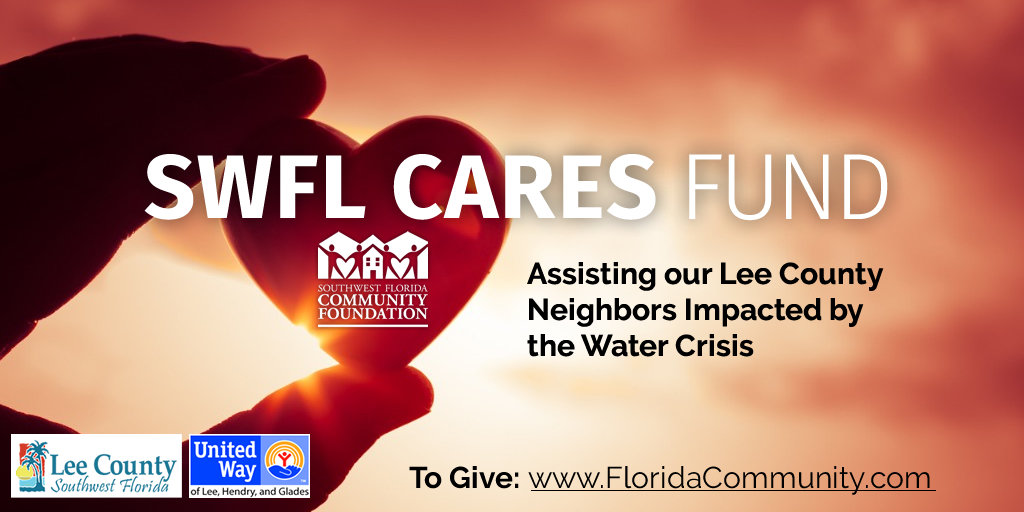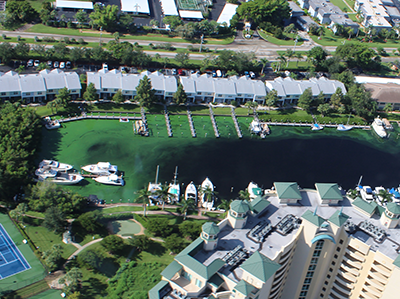In 2018, Lee County was struck by two distinctly different, but significant, events – red tide in the Gulf and blue-green algae in the river and canals of the Caloosahatchee River.
FWC's Red Tide Current Status Interactive Map
October 17 Update
U.S. Army Corps of Engineers Steps Down Releases to the Caloosahatchee
As South Florida enters the traditional dry season and water levels have declined on Lake Okeechobee, the U.S. Army Corps of Engineers has made operational changes to releases from Lake Okeechobee to the St. Lucie and the Caloosahatchee Rivers. The Corps has curtailed releases to the St. Lucie and has reduced releases to the Caloosahatchee. Both actions were taken at the request of local estuarine scientists.
While the Caloosahatchee has experienced high flow discharges since June, a gradual step-down in releases is less stressful to the estuarine aquatic life. When changing from the high flows of the wet season to the low flows of the dry season, it is preferable to gradually acclimate the Caloosahatchee Estuary to dry season flows. This allows the mobile, predominately freshwater aquatic species, time to migrate upstream. It also allows for non-mobile aquatic species, which are salt tolerant, a period to gradually adapt to the new more brackish habitat.
For optimal health of the Caloosahatchee Estuary, consistent dry season low-flows are necessary. Lee County will continue to work with the U.S. Army Corps of Engineers and the South Florida Water Management District to ensure adequate flows are provided to the Caloosahatchee throughout the dry season.
October 3 Update
Lee County Recovery Efforts Fact Sheet
Red Tide Recovery Efforts
• More than 2,000 tons of material removed from beaches and shorelines
• The county has purchased two Surf Rakes ($61,000 each) for beach and shoreline cleanup
• The largest beach clean in Lee County’s history
• County awarded $3 million in total grant money for red tide clean-up from the Florida Department of Environmental Protection
o County has also been awarded $77,500 portion of the $500,000 Visit Florida grant to bring tourism back to the area
Blue Green Algae Recovery Efforts
• More than 400,000 gallons of blue-green algae removed from waterways
• The county’s recent efforts to remove blue-green algae totaled an investment of $2,010,000.
Investment in Water Quality Projects
• $25 million spent on water quality projects in the last 10 years
• $12.2 million planned for future projects
• $96 million spent during last five years in capital and operations toward stormwater-management activities
• More than $350 million spent on purchase of almost 29,000 acres of Conservation 2020 land
County Economic Recovery Efforts
• Committed to up to $1 million (to be determined) response and recovery campaign once Red Tide abates. It will include
o Content campaign across traditional, social, and native channels
o Media tours with national and international outlets
o Targeted email campaigns
o Commercials in key markets
• 150 deals promoted on radio, print and social for the #OneLee campaign
• 20% estimated increased participation in Island Hopper – largest in 5 years (preliminary estimate)
• The Southwest Florida Community Foundation has partnered with United Way to established the SWFL Cares Fund to help individuals with incomes affected by the water crisis.
• The U.S. Small Business Administration (SBA) is providing low-interest loans for small businesses in counties affected by red tide and blue green algae.
• A donation from the SWFL community foundation paid for tolls during two, two-hour periods during Island Hopper on Captiva Island

Assistance for Lee County Residents and Businesses Impacted by Water Quality
As the county and region continue to face harmful algae blooms, community leaders and officials announced on Monday, Aug. 27 a new donation fund, as well as assistance available to businesses set up by the Southwest Florida Community Foundation.
The U.S. Small Business Administration (SBA) has issued a disaster declaration on red tide and a disaster declaration on the blue-green algae blooms that are caused by water releases from Lake Okeechobee. These disater declarations allow affected small businesses to apply for low-innerest Economic Injusry Disaster Loans from the SBA.
September 20 Update
Grant funding:
- The county has just obtained an additional $1,090,000 grant from the Florida Department of Environmental Protection for red tide cleanup, bringing the total to $3 million for this effort. In addition, the county's blue-green algae removal vendor will continue to collect algae through next week (a $2,010,000 effort in total).
Marine debris:
- Between Aug. 1 and Sept. 11, the total amount of red tide marine debris collected by the county, its contractor and municipalities (Fort Myers Beach and Sanibel) total 4,143,577 pounds.
News and updates:
Causeway tolls
- Motorists who cross the Sanibel Causeway between 11 a.m. and 1 p.m. Saturday, Sept. 22, and Sunday, Sept. 23, will not have to pay a toll. A donation from the Southwest Florida Community Foundation will cover the costs during those hours as a way to encourage locals to support Captiva and Sanibel businesses, many of which are feeling economic impacts from the lingering red tide.
- Lee County Department of Transportation will place message boards today to inform motorists of the hours and dates when tolls will be covered by the foundation's donation.
Beaches and parking
- Efforts by the City of Sanibel and Lee County continue on the island's beaches and shorelines to pick up dead fish and other marine debris that has been killed by red tide and has washed inland.
- The City of Sanibel has suspended parking fees at all Sanibel beaches this month.
- Lee County Parks & Recreation is waiving parking fees now through Sept. 30 at Lynn Hall Memorial Park, 950 Estero Blvd., and Bowditch Point Park, 50 Estero Blvd. Both parks are located on Fort Myers Beach. (Visit
www.leeparks.org.)
- The county fee waiver mirrors a decision last week by the Town of Fort Myers Beach to extend the free parking at its sites until the end of the month to assist businesses impacted by red tide.
SWFL Cares
- The donation from the Southwest Florida Community Foundation toward the Causeway tolls is a separate foundation effort from one announced earlier this month called SWFL Cares. That fund is designed to collect donations to be dispersed through United Way-affiliated nonprofit organizations to help families and individuals who have seen lost wages and other economic impacts due to red tide and blue-green algae. The foundation has already dispersed nearly $30,000 in donations to United Way. (Visit
https://floridacommunity.com.)
- The Island Hopper Songwriter Fest also is partnering with the foundation on this effort. Music fans can make a donation during Island Hopper Fest by texting GIVESWFL to 444999. Donations will go directly to the SWFL Cares Fund.
September 18 Update
The Florida Department of Environmental Protection (DEP) has provided $3.9 million in funding to Lee County to support efforts to battle red tide and blue-green algae. This includes the previously announced dollar amounts from DEP of $1.9 million for red tide cleanup and $1.3 million for blue-green algae cleanup. Also included is an additional $750,000 that will be divided between the two cleanup efforts.
Blue-green algae cleanup continues by the county’s vendor, AECOM, in Cape Coral canals. As of Monday, Sept. 17, the county contractor has collected and processed 275,000 gallons of algae slurry from six North Fort Myers canals and nine Cape Coral canals.
County staff and DEP continue to discuss other types of cleanup technology. A demonstration project at no cost to the county by a company called Solitude Lake Management, which uses nano-bubble technology, is anticipated to begin on Sept. 24 in North Fort Myers.
Red tide cleanup continues. Large quantities of marine life began washing ashore in Boca Grande, Captiva and Sanibel over the weekend of Sept. 15-16. The county continues to use county staff, Surf Rakes and its contracted CrowderGulf.
September 14 Update
Harmful Algal Bloom update
Staff continues to work with DEP for additional funding opportunities to continue efforts of red tide and blue-green algae cleanup.
The county’s vendor AECOM, which continues to process slurry but had suspended collection Wednesday this week, will resume collections next week.
Aerial surveys by staff continue so we can better assess both blue-green algae and red tide impacts. Today’s flight indicates that the blue-green algae is starting to slowly recede. However, the seven-day forecast indicates further development with red-tide marine debris.
September 11 Update
Lee County’s blue-green algae cleanup pilot program continues. Totals to date, from the county’s vendor, AECOM:
• Collected 250,000 gallons of algae slurry
• Processed 242,000 gallons of algae at the facility in North Fort Myers
• Cleaned 15 canal locations
September 4 Update
Blue/Green Algae Update:
• The Florida Department of Environmental Protection (DEP) staff is discussing allocating additional funds in an amount to be determined for another demonstration project with a company called Ecosphere.
• Lee County is in contract negotiations with Ecosphere.
• Ecosphere and the county are working on a draft Work Plan for approval by DEP.
Totals to date, the county’s first vendor, AECOM, has:
• Collected 190,000 gallons of algae slurry
• Processed 100,000 gallons of algae at the facility in North Fort Myers
• Large quantities of marine life began washing ashore in northern Sanibel and Captiva Islands beaches Aug. 22.
• Easterly winds have prevailed since Aug. 27 and have helped push most of the floating fish away from shorelines and beaches and into the Gulf of Mexico.
• CrowderGulf, the county’s contracted vendor for red tide cleanup, has crews on boats sincd Aug. 22 collecting dead fish from the canals of St. James City, Upper Captiva’s Safety Harbor, South Seas’ Harbor and the eastern side of Captiva.
• Lee County Parks & Recreation staff members have maintained clean-up efforts at Lee County park locations with the assistance of the new Surf Rakes.
• 48 tons of marine debris collected from Captiva from Aug. 22 through Aug. 27.
• 2,100 tons of marine debris collected throughout Lee County.
August 28 Update
The County’s grant award from FDEP for both blue-green algae and red tide cleanup has been increased by $1.17 million. The total grant amount is now $3.17 million and includes: a) $1.26 million for blue-green algae remediation; and b) $1.91 million for red tide related efforts.
Lee County anticipates resuming blue-green algae collection operations later this week and are working out details now with AECOM. Collection will likely begin in the City of Cape Coral, as this area apears to have the greatest number of severely impacted canals. Please note that Cape Coral is conducting its own demonstration project in conjunction with FDEP to determine the effectiveness of a product offered by Ecological Laboratories. Although the County is not a part of that project, staff will closely monitor its progress.
Red tide cleanup crews have collected nearly 2,000 tons of marine related material county-wide. County staff continue daily cleanup operations and contract crews supplement beach and canal related efforts as needed. In the meantime, we are working with the County Attorney’s Office to get Interlocal Agreements in place with Fort Myers Beach and Sanibel that will allow the County to reimburse city expenditures for eligible cleanup costs. These reimbursements will be made from a combination of FDEP grant funds and Tourist Development Tax revenue.
August 21 Update
Governor Rick Scott, on August 20th, requested the U.S. Small Business Administration issue an Economic Injury Disaster Declaration to help Florida businesses that are being impacted by algal blooms caused by federal water releases from Lake Okeechobee. The declaration will provide small businesses with low-interest loans so they can recover from the harm caused by these blooms. The Governor requested this declaration for Lee and Martin counties. Once the SBA has approved for these counties, the state will quickly work to include other areas that have been impacted.
Click
HERE to view the request.
Information is being collected to submit to the SBA so similar relief can be provided to businesses affected by naturally-occurring red tide. Last week, Governor Scott issued an Emergency Order for red tide, and last month, Governor Scott issued an Emergency Order for blue-green algae. For more information about the SBA disaster assistance loans, please visit
https://www.sba.gov/offices/headquarters/oda
The local Small Business Development Center at FGCU is reaching out to those businesses who complete the damage assessment surveys and indicate they want more information on bridge loans.
https://fsbdcswfl.org/ The contact for the local SBDC is:
Suzanne Specht, Assistant Director
FSBDC at Florida Gulf Coast University
Lutgert College of Business
10501 FGCU Blvd. S
Lutgert College of Business, #2321
Fort Myers FL 33965-6502
P
239.745.3704
sspecht@fgcu.edu
www.fsbdcswfl.org
Businesses being affected by the Lake Okeechobee Blue-Green Algae and Red Tide are encouraged to complete a business damage assessment survey that can be accessed at
https://floridadisaster.biz/BusinessDamageAssessments, and then select as applicable the “Lake Okeechobee Discharge/Algae Blooms” or the “Southwest Florida Red Tide” event.
This is what Lee County – in conjunction with its cities – is doing to clean up these two events.
Links below to learn more about Lee County's immediate actions:
 Grant Funding of $700,000 Grant Funding of $700,000
Test Cleanup Project Begun Declared State of Local Emergency
More Information... |
 Tourist Tax Funded Tourist Tax Funded
Debris Removal Contractor Hired
Public Dumpster Locations
More Information...
|
Board actions:
The Board at its regularly scheduled Aug. 7 meeting:
- Voted unanimously to ask for federal resources. The Board’s resolution urges President Trump to recognize a major disaster exists in Lee County because of the high concentration and prolonged presence of harmful red tide in the Gulf of Mexico and harmful blue-green algal blooms in the Caloosahatchee River and surrounding waters.
-
Heard from mayors and representatives the county’s six municipalities, who adopted their own State of Local Emergency.
-
Extended the existing county State of Local Emergency for blue-green algae and issued a second State of Local Emergency for red tide.
The Board at its Aug. 21 meeting is anticipated to approve several agenda items that will use Tourist Development Tax reserve funds for beach cleanup and marketing (see below under “Coastal” update).
Additional updates:
Tallahassee representatives of the Florida Department of Environmental Protection and the Florida Fish & Wildlife Conservation Commission met with Lee County’s senior leadership team Wednesday to discuss red tide and blue-green algae.
The Lee County Visitor & Convention Bureau participated in a statewide conference call Thursday with Visit Florida, the Florida Department of Health, Florida Fish & Wildlife Commission and MOTE Marine Laboratory and Aquarium regarding the red tide bloom affecting six counties along the Gulf of Mexico.
- VISIT FLORIDA is working with county tourism industry partners, state agencies and other stakeholders to mitigate the red tide's effects from a visitor perspective, and will communicate with visitors when the beaches are clear and back to normal. In addition, VISIT FLORIDA presented an action plan to ensure our partners, stakeholders and consumers are armed with updated information as we work together to manage and minimize the impacts of red tide.
What is Blue-green algae?
Blue-green algae, cyanobacteria, is a phylum of bacteria. It can be found in almost every land and water habitat. It is photosynthetic and blooms are common in waters polluted by nitrogen wastes. It consumes water’s dissolved oxygen that can cause fish and other aquatic organisms to die. It can grow in fresh, brackish or marine water.
Blooms happen when normally-occurring algae grows quickly. It initially causes the water to look cloudy and will start to form foam, scum or mats on the water surface and as the algae dies may cause the water to smell bad.
These blooms can threaten animals, people and the environment. Animals and humans should avoid contact with bodies of water that have blooms present. Exposure to the blooms can cause runny eyes and nose, sore throat, allergic reactions and swallowing the water can cause a variety of illnesses including gastroenteritis. Humans are less likely to be affected by the bloom as they are put off by the look and smell of the water. Dogs are more likely to be affected by swimming in the water and either drinking directly or licking their fur after being in the water.
What is Florida red tide?
Florida red tide is a common term describing a higher-than-normal concentration of a certain algae type. Most common to Florida and the Gulf of Mexico is Karenia brevis, K. brevis abbreviated. There are three components that are needed to form a bloom: biology, chemistry and physical conditions. The organism must be present in the water, have the nutrients to grow and conditions conducive to concentrate and transport K. brevis.
Higher concentrations of K. brevis can discolor water to a red or brown color but the water could also remain its normal color.
Florida red tide kills fish by producing a toxin called brevetoxin. This toxin affects the central nervous system of fish and can also affect birds, mammals and other marine animals. K. brevis can also affect humans, causing skin irritation and irritation to the respiratory system.